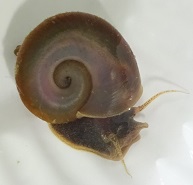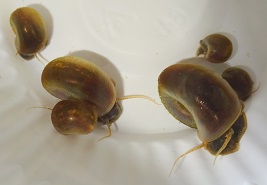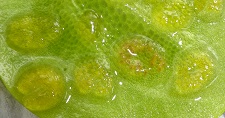| Home | Nature Weekly Index |
9 October 2016 | Freshwater Snail | Indoplanorbis exustus |

 Several weeks after I added 2 new aquatic plants
(Water Lily and Hornwort) to my
mini aquarium, I found a new freshwater snail in the tank. It was a relatively large snail of around 10 millimetres in
diameter. Due to its relatively common status, it did not take me too long to track down its identity. It was an
air-breathing freshwater snail known scientifically as
Indoplanorbis exustus from the ram's horn snail
family (Planorbidae). Needless to say, the snail came along with the aquatic plants, which is a common route where
non-native snail species get spread around the world. It is considered an invasive snail due to it high reproductive rate
as well as it having both male and female reproductive organs in the same animal (a condition known as hermaphroditism)
making self-fertilization possible. But, this particular snail is already very common in Southeast Asia countries.
Several weeks after I added 2 new aquatic plants
(Water Lily and Hornwort) to my
mini aquarium, I found a new freshwater snail in the tank. It was a relatively large snail of around 10 millimetres in
diameter. Due to its relatively common status, it did not take me too long to track down its identity. It was an
air-breathing freshwater snail known scientifically as
Indoplanorbis exustus from the ram's horn snail
family (Planorbidae). Needless to say, the snail came along with the aquatic plants, which is a common route where
non-native snail species get spread around the world. It is considered an invasive snail due to it high reproductive rate
as well as it having both male and female reproductive organs in the same animal (a condition known as hermaphroditism)
making self-fertilization possible. But, this particular snail is already very common in Southeast Asia countries.
From the number of reports seen [1-4], this snail appeared to be very common in India as well and had been a handy experimental subject. It is the host of several parasites that may infect animals and humans [1, 5]. Despite the many reports focusing on its invasiveness and control, and parasitic host, pictures of the life snail were rarely available in the Internet.
 Its jelly-liked egg masses were horse-shoes shaped. Plenty of these egg masses could be found on the underside of the leaves of
the floating aquatic plants. The spread in the fish tank had been quite rapid. From just a single snail, I now had countless
of them. While this snail was flourishing, the smaller
Ramshorn Snail (Gyraulus convexiusculus) was
gone now while the population of the
Bladder Snail (Physa acuta) and
Mimic Lymnaea Snail (Pseudosuccinea columella)
was declining rapidly. The most persistent snail species since day one of the tank's operation was the
Amerianna carinata.
Its jelly-liked egg masses were horse-shoes shaped. Plenty of these egg masses could be found on the underside of the leaves of
the floating aquatic plants. The spread in the fish tank had been quite rapid. From just a single snail, I now had countless
of them. While this snail was flourishing, the smaller
Ramshorn Snail (Gyraulus convexiusculus) was
gone now while the population of the
Bladder Snail (Physa acuta) and
Mimic Lymnaea Snail (Pseudosuccinea columella)
was declining rapidly. The most persistent snail species since day one of the tank's operation was the
Amerianna carinata.
References:
[1] Aditya G, Raut SK. Destruction of Indoplanorbis exustus (Planorbidae) eggs by Pomacea bridgesi (Ampullariidae). Molluscan Research 2002;22:87-90. | Read article |
[2] Mantale A, Patil M. The effect of water quality on oviposition in freshwater pulmonate snail Indoplanorbis exustus. International Journal of Innovations in Bio-Sciences 2012;2(4):217-220.
[3] Mantale AB, Patil MU. Age related changes in reproductive activity and growth in Indoplanorbis exustus. Trends in Life Sciences 2012;1(2):9-12. | Read article |
[4] Goel HC, Parshar BD. Effect of temperature on the development of Indoplanorbis exustus (Mollusca: Pulmonata). Journal of Invertebrate Pathology 1979;33(3):378-380.
[5] Liu L, Mondal MM, Idris MA, Lokman HS, Rajapakse PJ, Satrija F, Diaz JL, Upatham ES, Attwood SW. The phylogeography of Indoplanorbis exustus (Gastropoda: Planorbidae) in Asia. Parasites & Vectors 2010;3:57. | Read article |